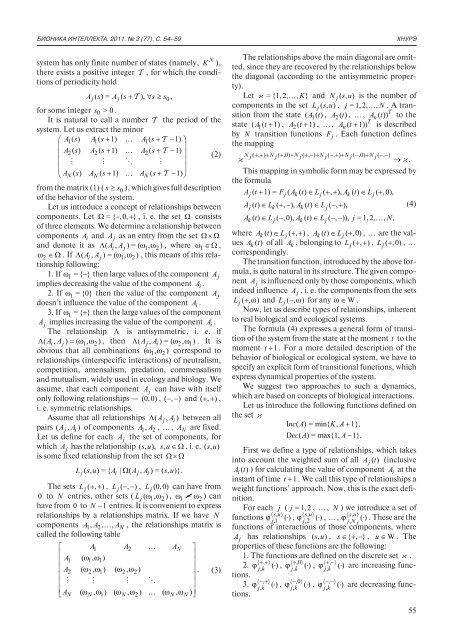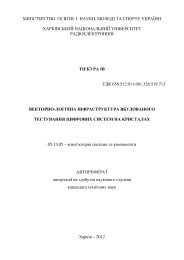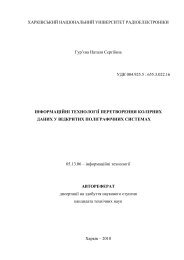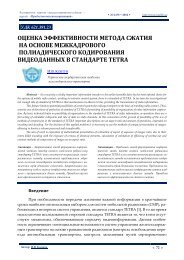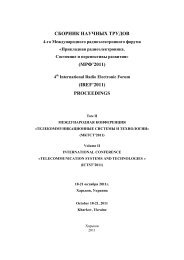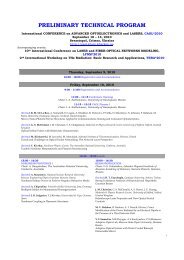информация, язык, интеллект № 3 (77) 2011
информация, язык, интеллект № 3 (77) 2011
информация, язык, интеллект № 3 (77) 2011
Create successful ePaper yourself
Turn your PDF publications into a flip-book with our unique Google optimized e-Paper software.
БИОНИКА ИНТЕЛЛЕКТА. <strong>2011</strong>. <strong>№</strong> 3 (<strong>77</strong>). С. 54–59 хНурэ<br />
N<br />
system has only finite number of states (namely, K ),<br />
there exists a positive integer T , for which the conditions<br />
of periodicity hold<br />
Aj( s) = Aj( s+ T ), ∀s ≥ s0,<br />
for some integer s 0 > 0.<br />
It is natural to call a number T the period of the<br />
system. Let us extract the minor<br />
⎛ A1( s) A1( s+ 1) … A1( s+<br />
T −1)<br />
⎞<br />
⎜ ⎟<br />
⎜<br />
A2( s) A2( s+ 1) … A2( s+<br />
T −1)<br />
⎟ (2)<br />
⎜ ⎟<br />
⎜ ⎟<br />
⎝AN( s) AN( s+ 1) … AN( s+<br />
T −1)<br />
⎠<br />
from the matrix (1) ( s ≥ s0),<br />
which gives full description<br />
of the behavior of the system.<br />
Let us introduce a concept of relationships between<br />
components. Let Ω = { − ,0, + } , i. e. the set Ω consists<br />
of three elements. We determine a relationship between<br />
components i A and A j as an entry from the set Ω×Ω<br />
and denote it as Λ ( Ai, Aj) = ( ω1, ω2)<br />
, where ω1 ∈Ω,<br />
ω2 ∈Ω . If Λ ( Ai, Aj) = ( ω1, ω2)<br />
, this means of this relationship<br />
following:<br />
1. If ω1 ={ − } then large values of the component j A<br />
implies decreasing the value of the component A i .<br />
2. If 1 = {0} ω then the value of the component j A<br />
doesn’t influence the value of the component A i .<br />
3. If ω 1 ={ + } then the large values of the component<br />
A j implies increasing the value of the component A i .<br />
The relationship Λ is antisymmetric, i. e. if<br />
Λ ( Ai, Aj) = ( ω1, ω2)<br />
, then Λ ( Aj, Ai) = ( ω2, ω1)<br />
. It is<br />
obvious that all combinations ( ω1, ω 2)<br />
correspond to<br />
relationships (interspecific interactions) of neutralism,<br />
competition, amensalism, predation, commensalism<br />
and mutualism, widely used in ecology and biology. We<br />
assume, that each component A j can have with itself<br />
only following relationships — (0,0) , ( −, − ) and ( + , + ) ,<br />
i. e. symmetric relationships.<br />
Assume that all relationships Λ ( Aj, Ai)<br />
between all<br />
pairs ( Aj, A i)<br />
of components A1, A 2 , … , A N are fixed.<br />
Let us define for each A j the set of components, for<br />
which A j has the relationship ( s, u ), s, u∈Ω, i. e. ( s, u )<br />
is some fixed relationship from the set Ω×Ω<br />
Lj( s, u) ={ Ai | Ω(<br />
Aj, Ai) = ( s, u)}.<br />
The sets L j ( + , + ) , L j ( −, − ) , L j (0,0) can have from<br />
0 to N entries, other sets ( L j ( ω1, ω 2)<br />
, ω1 = ω 2)<br />
can<br />
have from 0 to N − 1 entries. It is convenient to express<br />
relationships by a relationships matrix. If we have N<br />
components A1, A2, … , AN,<br />
the relationships matrix is<br />
called the following table<br />
⎡ A1 A2 … AN⎤<br />
⎢<br />
A1<br />
( ω1, ω1)<br />
⎥<br />
⎢ ⎥<br />
⎢ A2<br />
( ω2, ω1) ( ω2, ω2)<br />
⎥.<br />
⎢ ⎥<br />
⎢ ⎥<br />
⎢<br />
⎣AN ( ωN, ω1) ( ωN, ω2) … ( ωN, ωN)<br />
⎥<br />
⎦<br />
(3)<br />
The relationships above the main diagonal are omitted,<br />
since they are recovered by the relationships below<br />
the diagonal (according to the antisymmetric property).<br />
Let = {1, 2, …,<br />
K}<br />
and Nj( s, u ) is the number of<br />
components in the set Lj( s, u ) , j = 1, 2, … , N . A transition<br />
from the state ( A1( t ) , A2 ( t ) , … , An( t ))T to the<br />
state ( A1( t + 1) , A2 ( t + 1) , … , An( t + 1))T is described<br />
by N transition functions F j . Each function defines<br />
the mapping<br />
Nj( + , + ) + Nj( + ,0) + Nj( + , − ) + Nj( − , + ) + Nj( − ,0) + Nj(<br />
−, −) → .<br />
This mapping in symbolic form may be expressed by<br />
the formula<br />
Aj( t + 1) = Fj( Ak( t) ∈ Lj( + , + ), Ak( t) ∈ Lj(<br />
+ ,0),<br />
Aj( t) ∈ Lk( + , −), Ak( t) ∈Lj( − , + ),<br />
(4)<br />
Ak( t) ∈Lj( −,0), Ak( t) ∈Lj( −, −)), j = 1, 2, …,<br />
N,<br />
where Ak( t) ∈ Lj(<br />
+ , + ) , Ak( t) ∈ Lj(<br />
+ ,0) , … are the values<br />
Ak( t ) of all A k , belonging to L j ( + , + ) , L j ( + ,0) , …<br />
correspondingly.<br />
The transition function, introduced by the above formula,<br />
is quite natural in its structure. The given component<br />
A j is influenced only by those components, which<br />
indeed influence A j , i. e. the components from the sets<br />
L j ( + , ω)<br />
and L j ( − , ω)<br />
for any ω ∈ W .<br />
Now, let us describe types of relationships, inherent<br />
to real biological and ecological systems.<br />
The formula (4) expresses a general form of transition<br />
of the system from the state at the moment t to the<br />
moment t + 1 . for a more detailed description of the<br />
behavior of biological or ecological system, we have to<br />
specify an explicit form of transitional functions, which<br />
express dynamical properties of the system.<br />
We suggest two approaches to such a dynamics,<br />
which are based on concepts of biological interactions.<br />
Let us introduce the following functions defined on<br />
the set <br />
I nc( A) = min{ K, A + 1},<br />
D ec( A) = max{1, A −1}.<br />
first we define a type of relationships, which takes<br />
into account the weighted sum of all Aj( t ) (inclusive<br />
Ai( t ) ) for calculating the value of component A i at the<br />
instant of time t + 1 . We call this type of relationships a<br />
weight functions’ approach. Now, this is the exact definition.<br />
for each j ( j = 1, 2 , … , N ) we introduce a set of<br />
,<br />
functions , 1 ()<br />
s u<br />
ϕ j<br />
〈 〉 ,<br />
⋅ , ,2 ()<br />
s u<br />
ϕ j<br />
〈 〉 〈 s, u〉<br />
⋅ , … , ϕ () ⋅ . These are the<br />
j, Nj functions of interactions of those components, where<br />
A j has relationships ( s, u ) , s ∈ { + , − } , u ∈ W . The<br />
properties of these functions are the following:<br />
1. The functions are defined on the discrete set .<br />
,<br />
2. ϕ j, k ()<br />
〈+ +〉 ,0<br />
⋅ , ϕ j, k ()<br />
〈+ 〉 ,<br />
⋅ , ϕ j, k ()<br />
〈+ −〉 ⋅ are increasing functions.<br />
,<br />
3. ϕ j, k ()<br />
〈− +〉 ,0<br />
⋅ , ϕ j, k ()<br />
〈− 〉 ,<br />
⋅ , ϕ j, k ()<br />
〈− −〉 ⋅ are decreasing functions.<br />
55


